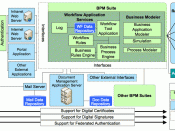OracleDatabase Management Systems can be found everywhere inside and outside the workplace. For example, Database Management Systems at work would include inventory systems, flight reservation systems and computerized library systems. Outside the workplace one would find DBMS's such as an Automated Teller Machine or ATM. DBMS's have become a very important part of everyday business not just because of their effectiveness, but also their advantages and in this report, we will discuss the advantages that the Oracle RDBMS gives us.
The Oracle RDBMS stores data logically in the form of tablespaces and physically in the form of data files. Tablespaces can contain various types of memory segments; for example, Data Segments, Index Segments etc. Segments comprise of one or more extents that group contiguous data blocks that form the basic units of data storage. At the physical level, data files comprise one or more data blocks, where the block size can vary between data files.
Oracle database management tracks its computer data storage with the help of information stored in the SYSTEM tablespace. The SYSTEM tablespace contains the data dictionary and often by default indexes and clusters. A data dictionary consists of a special collection of tables that contains information about all user objects in the database. This tablespace structure will give businesses accuracy and will be easily managed with the data storage options that are available.
Oracle content management software is the industry's most unified enterprise content management platform that enables clients to leverage industry leading document management, Web content management, digital asset management, and records management functionality to build their 2business applications. Building a strategic enterprise content management infrastructure for content and applications helps customers to reduce costs, easily share content across the enterprise, minimize risk, automate expensive, time-intensive and manual processes, and consolidate multiple Web sites...


